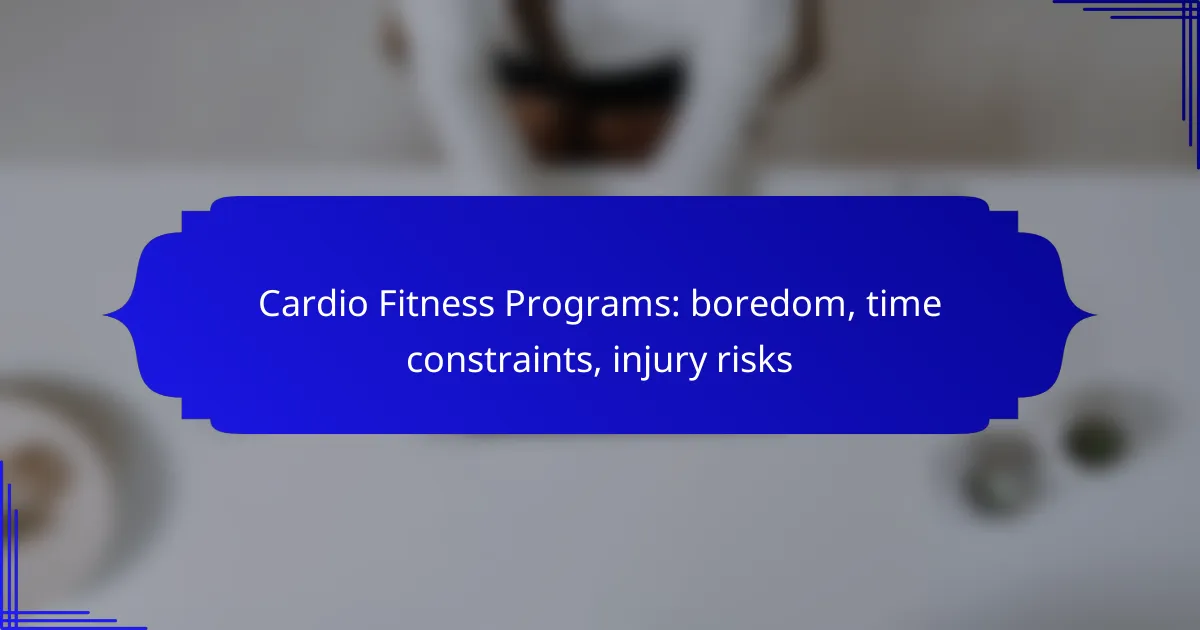Cardio fitness programs can often lead to boredom, especially when routines become repetitive. To maintain motivation, it’s essential to introduce variety and explore different formats. Additionally, time constraints can make it challenging to fit effective workouts into a busy schedule, but with strategic planning and high-intensity options, you can maximize your cardio benefits. However, it’s important to be aware of injury risks associated with high-impact activities, which can range from minor strains to more serious conditions.

How can you overcome boredom in cardio fitness programs?
To overcome boredom in cardio fitness programs, incorporate variety and engage with different formats and environments. This approach keeps workouts fresh and motivates you to stay consistent.
Incorporating variety with HIIT workouts
High-Intensity Interval Training (HIIT) is an effective way to add variety to your cardio routine. By alternating between short bursts of intense activity and periods of rest, you can keep your workouts engaging and efficient.
Consider mixing different exercises such as sprinting, cycling, or bodyweight movements. A typical HIIT session might last 20-30 minutes, making it a time-efficient option that can be done anywhere.
Using fitness apps like Peloton
Fitness apps like Peloton offer a wide range of cardio workouts that can be done at home or in the gym. These platforms provide access to live and on-demand classes, allowing you to choose workouts that match your interests and fitness level.
Look for features such as guided sessions, leaderboards, and community challenges to enhance your experience. Many apps also allow you to track your progress, which can help maintain motivation.
Joining group classes at local gyms
Participating in group classes at local gyms can significantly reduce boredom in cardio workouts. Classes such as Zumba, spin, or kickboxing provide a social environment that can make exercising more enjoyable.
Check your local gym schedule for a variety of classes that fit your interests and availability. Engaging with others can also provide accountability and encouragement, enhancing your overall fitness journey.
Setting personal challenges and goals
Setting personal challenges and goals can keep your cardio fitness program exciting. Establish specific, measurable targets such as running a certain distance or completing a set number of workouts each week.
Consider using a journal or fitness tracker to monitor your progress and celebrate achievements. This approach not only combats boredom but also fosters a sense of accomplishment and motivation to continue improving.

What are effective time management strategies for cardio fitness?
Effective time management strategies for cardio fitness include optimizing workout duration and planning sessions in advance. By incorporating short, high-intensity workouts and utilizing quick home workout videos, you can fit cardio into a busy schedule without sacrificing quality.
Short, high-intensity workouts
Short, high-intensity workouts, often referred to as HIIT (High-Intensity Interval Training), can be completed in as little as 15-30 minutes. These sessions alternate between intense bursts of activity and short rest periods, maximizing calorie burn and cardiovascular benefits in a limited timeframe.
Consider incorporating exercises like sprinting, jumping jacks, or burpees into your routine. Aim for 20-30 seconds of intense effort followed by a brief rest, repeating for several rounds. This method not only saves time but also keeps workouts engaging and effective.
Scheduling workouts in advance
Scheduling workouts in advance is crucial for maintaining consistency in your cardio fitness routine. Set specific days and times for your workouts, treating them like important appointments that cannot be missed.
Use a calendar or fitness app to block out time for your sessions. Aim for at least three to five cardio workouts per week, adjusting based on your availability. This proactive approach helps reduce the likelihood of skipping workouts due to time constraints.
Utilizing quick home workout videos
Quick home workout videos are an excellent resource for fitting cardio into a busy lifestyle. Many platforms offer 10-20 minute sessions that require little to no equipment, making it easy to exercise at home.
Look for videos that focus on cardio-intensive routines, such as dance, kickboxing, or bodyweight circuits. These can be easily integrated into your day, whether during a lunch break or after work. Aim to try different styles to keep your routine fresh and enjoyable.

What are the injury risks associated with cardio fitness?
Cardio fitness programs, particularly those involving high-impact activities like running, carry various injury risks. Common injuries can range from minor strains to more serious conditions that may require medical attention.
Common injuries from running
Running can lead to several common injuries, including shin splints, runner’s knee, and plantar fasciitis. These injuries often result from overuse, improper technique, or inadequate recovery time. Runners may experience pain in specific areas, which can hinder their ability to continue training effectively.
Other injuries such as Achilles tendinitis and stress fractures can occur due to repetitive stress on the body. It’s crucial for runners to listen to their bodies and recognize early signs of discomfort to prevent more severe injuries.
Preventative measures for injury
To minimize injury risks, it’s essential to incorporate proper warm-up and cool-down routines into your cardio workouts. Stretching and mobility exercises can enhance flexibility and prepare muscles for activity. Additionally, gradually increasing workout intensity and duration can help the body adapt without excessive strain.
Cross-training with low-impact activities, such as swimming or cycling, can also reduce the risk of overuse injuries. This approach allows for cardiovascular fitness while giving specific muscle groups a break from repetitive stress.
Importance of proper footwear
Wearing the right footwear is critical for preventing injuries during cardio workouts. Proper running shoes should provide adequate support, cushioning, and fit to accommodate your foot type and running style. Shoes that are worn out or not suited for your specific needs can lead to discomfort and injuries.
It’s advisable to replace running shoes every 300 to 500 miles, depending on your running habits and terrain. Visiting a specialty running store for a fitting can help ensure you choose the best footwear for your individual biomechanics.

How do you choose the right cardio program for your needs?
Choosing the right cardio program involves evaluating your fitness level, personal goals, and any potential limitations. A well-suited program should keep you engaged while fitting into your schedule and minimizing injury risks.
Assessing fitness level and goals
Begin by determining your current fitness level, which can range from beginner to advanced. Consider factors such as your endurance, strength, and any previous experience with cardio activities. Setting clear goals, whether for weight loss, improved endurance, or overall health, will guide your program selection.
For example, if you’re a beginner, starting with low-impact activities like walking or cycling may be beneficial. In contrast, advanced individuals might opt for high-intensity interval training (HIIT) or running. Regularly reassess your progress to adjust your goals and program as needed.
Consulting with fitness professionals
Engaging with fitness professionals can provide tailored advice and help you navigate your options. Personal trainers or fitness coaches can assess your abilities and recommend specific cardio programs that align with your goals and preferences.
Consider seeking a professional who specializes in your areas of interest, such as running coaches for runners or trainers with experience in rehabilitation for those with injury concerns. They can help you avoid common pitfalls and ensure your program is both effective and safe.

What are the benefits of cross-training in cardio fitness?
Cross-training in cardio fitness offers a variety of benefits, including reduced boredom and enhanced overall performance. By incorporating different forms of exercise, individuals can maintain motivation while minimizing the risk of injury.
Reducing injury risk
Cross-training helps reduce injury risk by allowing different muscle groups to rest while others are engaged. For example, alternating between running, cycling, and swimming can prevent overuse injuries common in repetitive activities. This variety keeps the body balanced and reduces strain on specific joints.
To effectively minimize injury, consider incorporating low-impact activities, such as cycling or swimming, into your routine. Aim for a mix of high-impact and low-impact exercises throughout the week to promote recovery and maintain fitness levels.
Improving overall fitness
Engaging in cross-training can significantly improve overall fitness by enhancing cardiovascular endurance, strength, and flexibility. By varying workouts, you challenge your body in new ways, which can lead to better performance across all activities. For instance, strength training can complement running by building muscle that supports endurance.
To maximize the benefits, aim for at least three different cardio activities each week. This could include a combination of running, cycling, and rowing, ensuring that you work different muscle groups and energy systems. Regularly assess your progress and adjust your routine to keep it challenging and effective.

How can technology enhance your cardio fitness experience?
Technology can significantly improve your cardio fitness experience by providing personalized data, engaging workouts, and convenient tracking. By leveraging tools like fitness trackers and virtual reality programs, you can stay motivated, monitor your progress, and reduce the risk of injury.
Wearable fitness trackers like Fitbit
Wearable fitness trackers, such as Fitbit, help monitor your heart rate, steps, and calories burned during cardio workouts. These devices provide real-time feedback, allowing you to adjust your intensity and duration based on your fitness goals.
When using a fitness tracker, aim to set achievable daily targets, like 10,000 steps or 30 minutes of moderate activity. Regularly reviewing your data can help identify patterns and areas for improvement, keeping your workouts fresh and engaging.
Virtual reality fitness programs
Virtual reality (VR) fitness programs offer immersive experiences that can make cardio workouts more enjoyable and less monotonous. These programs often include interactive games and environments that challenge you physically while keeping you entertained.
Consider trying VR fitness options that cater to various interests, such as dance, cycling, or adventure sports. Ensure your space is safe and free of obstacles to minimize injury risks while using VR equipment. Regularly switching up your VR workouts can help maintain your motivation and enthusiasm for cardio fitness.

What emerging trends are shaping cardio fitness programs?
Emerging trends in cardio fitness programs focus on enhancing engagement, accommodating time constraints, and minimizing injury risks. These trends include innovative workout formats, technology integration, and personalized training approaches that cater to diverse fitness levels and preferences.
Boredom in Cardio Workouts
Boredom is a common challenge in cardio workouts, often leading to decreased motivation and adherence. To combat this, many programs now incorporate varied formats such as interval training, circuit workouts, and gamified experiences that keep participants engaged.
Consider mixing different types of cardio exercises, such as cycling, running, and swimming, to maintain interest. Group classes or virtual challenges can also provide a social element that enhances enjoyment and commitment.
Time Constraints
Time constraints often hinder individuals from committing to regular cardio sessions. Many emerging programs address this by offering high-intensity interval training (HIIT) sessions that can be completed in 20-30 minutes, providing effective workouts in shorter durations.
To maximize efficiency, focus on compound movements that engage multiple muscle groups. Incorporating short, intense bursts of activity can yield significant cardiovascular benefits without requiring lengthy time commitments.
Injury Risks
Injury risks are a significant concern in cardio fitness, especially for beginners or those returning after a hiatus. Programs are increasingly emphasizing proper form, warm-up routines, and recovery strategies to minimize these risks.
Consider starting with low-impact options like cycling or swimming, which reduce stress on joints. Additionally, integrating strength training can help build muscle support around vulnerable areas, further decreasing the likelihood of injury during cardio activities.
